主流消息中间件介绍- RabbitMQ
RabbitMQ是使用 Erlang语言开发的开源消息队列系统,基于AMQP协议来实现。AMQP的主要特征是面向消息、队列、路由(包括点对点和发布,订阅)、可靠性、安全。AMQP协议更多用在企业系统内,对数据一致性、稳定性和可靠性要求很高的场景,对性能和吞吐量的要求还在其次。
RabbitMQ高性能的原因?
Erlang语言最初在于交换机领域的架构模式,这样使得RabbitMQ在 Broker之间进行数据交互的性能是非常优秀的
Erlang的优点: Erlang有着和原生 Socket一样的延迟
什么是AMQP高级消息队列协议?
AMQP定义:是具有现代特征的二进制协议。是一个提供统一消息服务的应用层标准高级消息队列协议,是应用层协议的一个开放
准,为面向消息的中间件设计。
AMQP协议模型
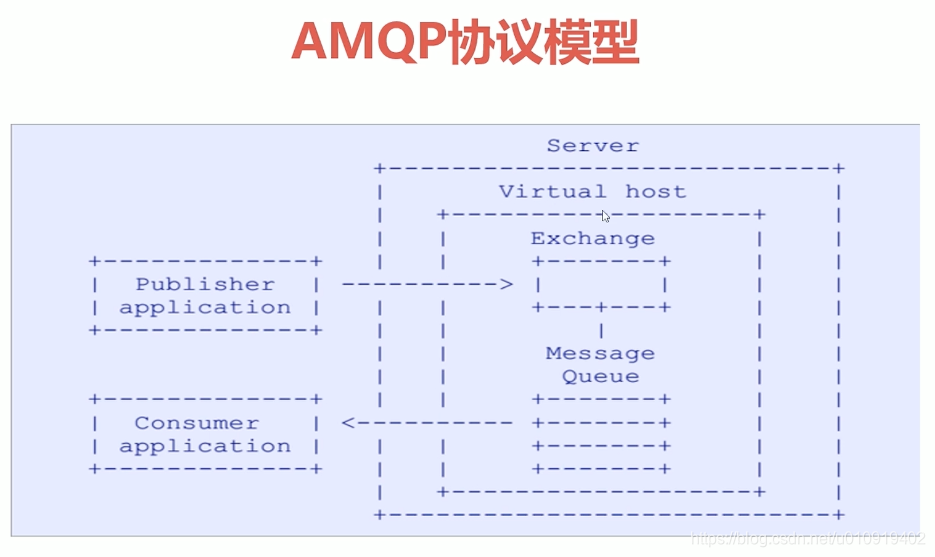
AMQP核心概念
Server:又称 Broker,接受客户端的连接,实现AMQP实体服务
Connection:连接,应用程序与 Broker的网络连接
Channel:网络信道,几乎所有的操作都在 Channe中进行, Channel是进行消息读写的通道。客户端可建立多个 Channel,每个 Channe代表一个会话任务。
Message:消息,服务器和应用程序之间传送的数据,由 Properties和Body组成。 Properties可以对消息进行修饰,比如消息的优先级、延迟等高级特性;Body则就是消息体内容。
Virtual host:虚拟地址,用于进行逻辑隔离,最上层的消息路由。一个Virtual host里面可以有若干个 Exchange和 Queue,同一个 Virtual Host里面不能有相同名称的 Exchange或 Queue
Exchange:交换机,接收消息,根据路由键转发消息到绑定的队列
Routing key:一个路由规则,虚拟机可用它来确定如何路由一个特定消息
Queue:也称为 Message Queue,消息队列,保存消息并将它们转发给消费者
RabbitMQ的整体架构是什么样子的?
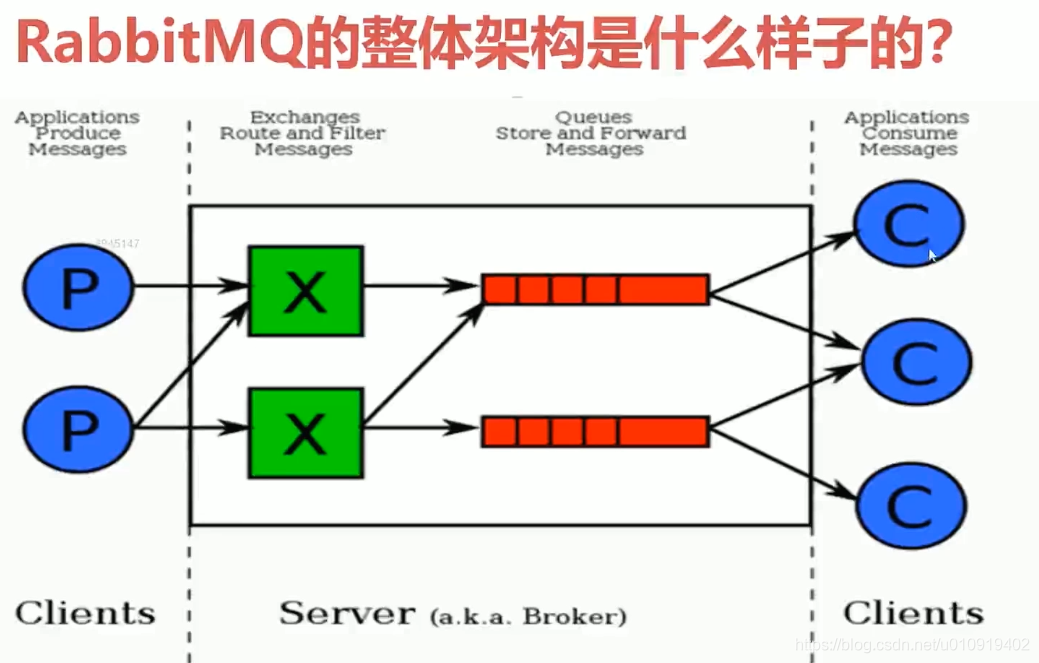
RabbitMQ消息是如何流转的?
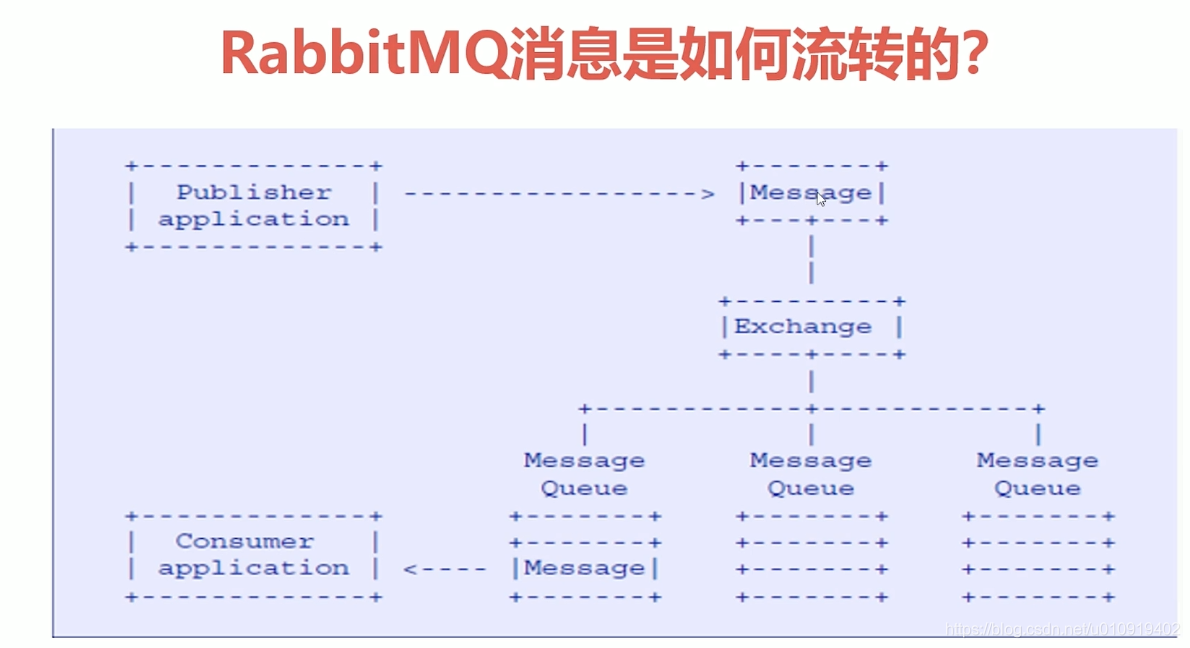
急速入门-消息生产与消费
Connection Factory:获取连接工厂
Connection:一个连接
Channel:数据通信信道,可发送和接收消息
Queue:具体的消息存储队列
Producer& Consumer生产和消费者
Procuder 生产
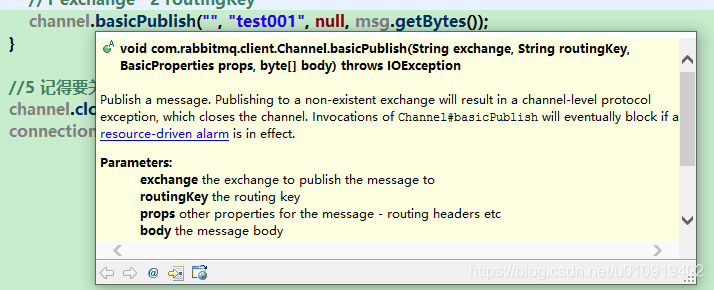
public class Procuder {
public static void main(String[] args) throws Exception {
//1 创建一个ConnectionFactory, 并进行配置
ConnectionFactory connectionFactory = new ConnectionFactory();
connectionFactory.setHost("127.0.0.1");
connectionFactory.setPort(5672);
connectionFactory.setVirtualHost("/");
//2 通过连接工厂创建连接
Connection connection = connectionFactory.newConnection();
//3 通过connection创建一个Channel
Channel channel = connection.createChannel();
//4 通过Channel发送数据
for(int i=0; i < 5; i++){
String msg = "Hello RabbitMQ!";
//1 exchange 2 routingKey
channel.basicPublish("", "test001", null, msg.getBytes());
}
//5 记得要关闭相关的连接
channel.close();
connection.close();
}
}
Consumer消费
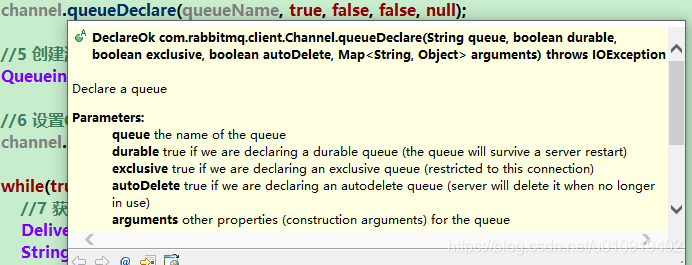
public class Consumer {
public static void main(String[] args) throws Exception {
//1 创建一个ConnectionFactory, 并进行配置
ConnectionFactory connectionFactory = new ConnectionFactory();
connectionFactory.setHost("127.0.0.1");
connectionFactory.setPort(5672);
connectionFactory.setVirtualHost("/");
//2 通过连接工厂创建连接
Connection connection = connectionFactory.newConnection();
//3 通过connection创建一个Channel
Channel channel = connection.createChannel();
//4 声明(创建)一个队列
String queueName = "test001";
channel.queueDeclare(queueName, true, false, false, null);
//5 创建消费者
QueueingConsumer queueingConsumer = new QueueingConsumer(channel);
//6 设置Channel
channel.basicConsume(queueName, true, queueingConsumer);
while(true){
//7 获取消息
Delivery delivery = queueingConsumer.nextDelivery();
String msg = new String(delivery.getBody());
System.err.println("消费端: " + msg);
//Envelope envelope = delivery.getEnvelope();
}
}
}
Exchange交换机
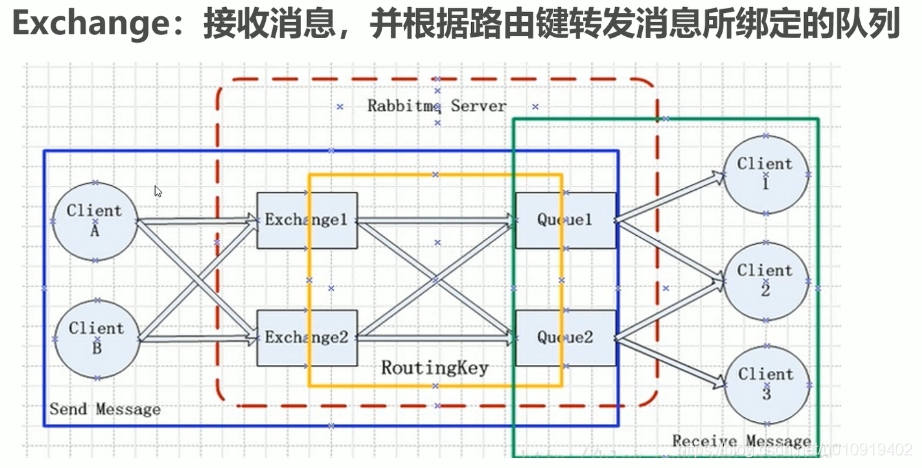
Exchange交换机属性
Name:交换机名称
Type:交换机类型 direct、 topic、 fanout、 headers
Durability:是否需要持久化,true为持久化
Auto delete:当最后一个绑定到 Exchange上的队列删除后,自动删除该 Exchange
Internal:当前 Exchange是否用于 RabbitMQ内部使用,默认为 False
Arguments:扩展参数,用于扩展AMQP协议自制定化使用
在rabbitmq中,exchange有4个类型:direct,topic,fanout,header。
Direct Exchange---直连routingKey 完全一致匹配
所有发送到 Direct Exchange的消息被转发到 RouteKey中指定的 Queue
注意: Direct模式可以使用 RabbitMQ自带的 Exchange: default Exchange,所以不需要将 Exchange进行任何绑定( binding操作,消息传递时, Routekey必须完全匹配才会被队列接收,否则该消息会被抛弃
DirectExchange
Producer4DirectExchange
public class Producer4DirectExchange {
public static void main(String[] args) throws Exception {
//1 创建ConnectionFactory
ConnectionFactory connectionFactory = new ConnectionFactory();
connectionFactory.setHost("127.0.0.1");
connectionFactory.setPort(5672);
connectionFactory.setVirtualHost("/");
//2 创建Connection
Connection connection = connectionFactory.newConnection();
//3 创建Channel
Channel channel = connection.createChannel();
//4 声明
String exchangeName = "test_direct_exchange";
String routingKey = "test.direct";
//5 发送
String msg = "Hello World RabbitMQ 4 Direct Exchange Message 111 ... ";
channel.basicPublish(exchangeName, routingKey , null , msg.getBytes());
}
}
Consumer4DirectExchange
public class Consumer4DirectExchange {
public static void main(String[] args) throws Exception {
ConnectionFactory connectionFactory = new ConnectionFactory() ;
connectionFactory.setHost("127.0.0.1");
connectionFactory.setPort(5672);
connectionFactory.setVirtualHost("/");
connectionFactory.setAutomaticRecoveryEnabled(true);
connectionFactory.setNetworkRecoveryInterval(3000);
Connection connection = connectionFactory.newConnection();
Channel channel = connection.createChannel();
//4 声明
String exchangeName = "test_direct_exchange";
String exchangeType = "direct";
String queueName = "test_direct_queue";
String routingKey = "test.direct";
//表示声明了一个交换机
channel.exchangeDeclare(exchangeName, exchangeType, true, false, false, null);
//表示声明了一个队列
channel.queueDeclare(queueName, false, false, false, null);
//建立一个绑定关系:
channel.queueBind(queueName, exchangeName, routingKey);
//durable 是否持久化消息
QueueingConsumer consumer = new QueueingConsumer(channel);
//参数:队列名称、是否自动ACK、Consumer
channel.basicConsume(queueName, true, consumer);
//循环获取消息
while(true){
//获取消息,如果没有消息,这一步将会一直阻塞
Delivery delivery = consumer.nextDelivery();
String msg = new String(delivery.getBody());
System.out.println("收到消息:" + msg);
}
}
}
Topic
Topic Exchange
所有发送到 Topic Exchange的消息被转发到所有关心 RouteKey中指定 Topic的 Queue上
Exchange将 RouteKey和某 Topic进行模糊匹配,此时队列需要绑定一个 Topic
注意:可以使用通配符进行模糊匹配


Producer4TopicExchange
public class Producer4TopicExchange {
public static void main(String[] args) throws Exception {
//1 创建ConnectionFactory
ConnectionFactory connectionFactory = new ConnectionFactory();
connectionFactory.setHost("127.0.0.1");
connectionFactory.setPort(5672);
connectionFactory.setVirtualHost("/");
//2 创建Connection
Connection connection = connectionFactory.newConnection();
//3 创建Channel
Channel channel = connection.createChannel();
//4 声明
String exchangeName = "test_topic_exchange";
String routingKey1 = "user.save";
String routingKey2 = "user.update";
String routingKey3 = "user.delete.abc";
//5 发送
String msg = "Hello World RabbitMQ 4 Topic Exchange Message ...";
String msg1 = "Hello1 World RabbitMQ 4 Topic Exchange Message ...";
String msg2 = "Hello2 World RabbitMQ 4 Topic Exchange Message ...";
channel.basicPublish(exchangeName, routingKey1 , null , msg1.getBytes());
channel.basicPublish(exchangeName, routingKey2 , null , msg.getBytes());
channel.basicPublish(exchangeName, routingKey3 , null , msg.getBytes());
channel.close();
connection.close();
}
}
Consumer4TopicExchange
public class Consumer4TopicExchange {
public static void main(String[] args) throws Exception {
ConnectionFactory connectionFactory = new ConnectionFactory() ;
connectionFactory.setHost("127.0.0.1");
connectionFactory.setPort(5672);
connectionFactory.setVirtualHost("/");
connectionFactory.setAutomaticRecoveryEnabled(true);
connectionFactory.setNetworkRecoveryInterval(3000);
Connection connection = connectionFactory.newConnection();
Channel channel = connection.createChannel();
//4 声明
String exchangeName = "test_topic_exchange";
String exchangeType = "topic";
String queueName = "test_topic_queue";
String routingKey = "user.#";
// String routingKey = "user.save";
// String routingKey = "user.*";
// 1 声明交换机
channel.exchangeDeclare(exchangeName, exchangeType, true, false, false, null);
// 2 声明队列
channel.queueDeclare(queueName, false, false, false, null);
// 3 建立交换机和队列的绑定关系:
channel.queueBind(queueName, exchangeName, routingKey);
//durable 是否持久化消息
QueueingConsumer consumer = new QueueingConsumer(channel);
//参数:队列名称、是否自动ACK、Consumer
channel.basicConsume(queueName, true, consumer);
//循环获取消息
while(true){
//获取消息,如果没有消息,这一步将会一直阻塞
Delivery delivery = consumer.nextDelivery();
String msg = new String(delivery.getBody());
System.out.println("收到消息:" + msg);
}
}
}
Fanout
Fanout Exchange
不处理路由键,只需要简单的将队列绑定到交换机上
发送到交换机的消息都会被转发到与该交换机绑定的所有队列上
Fanout交换机转发消息是最快的
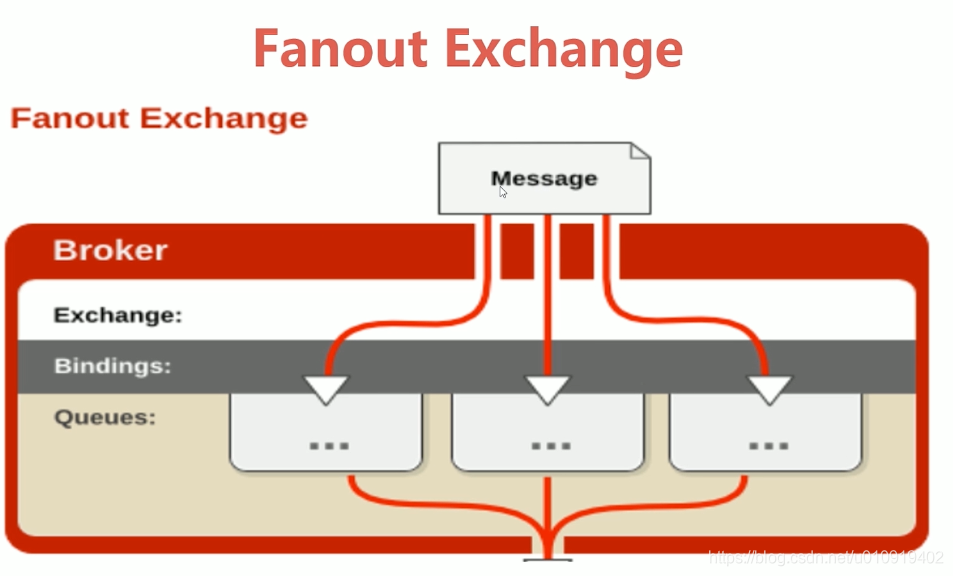
Consumer4FanoutExchange
public class Consumer4FanoutExchange {
public static void main(String[] args) throws Exception {
ConnectionFactory connectionFactory = new ConnectionFactory() ;
connectionFactory.setHost("127.0.0.1");
connectionFactory.setPort(5672);
connectionFactory.setVirtualHost("/");
connectionFactory.setAutomaticRecoveryEnabled(true);
connectionFactory.setNetworkRecoveryInterval(3000);
Connection connection = connectionFactory.newConnection();
Channel channel = connection.createChannel();
//4 声明
String exchangeName = "test_fanout_exchange";
String exchangeType = "fanout";
String queueName = "test_fanout_queue";
String routingKey = ""; //不设置路由键
channel.exchangeDeclare(exchangeName, exchangeType, true, false, false, null);
channel.queueDeclare(queueName, false, false, false, null);
channel.queueBind(queueName, exchangeName, routingKey);
//durable 是否持久化消息
QueueingConsumer consumer = new QueueingConsumer(channel);
//参数:队列名称、是否自动ACK、Consumer
channel.basicConsume(queueName, true, consumer);
//循环获取消息
while(true){
//获取消息,如果没有消息,这一步将会一直阻塞
Delivery delivery = consumer.nextDelivery();
String msg = new String(delivery.getBody());
System.out.println("收到消息:" + msg);
}
}
}
Producer4FanoutExchange
public class Producer4FanoutExchange {
public static void main(String[] args) throws Exception {
//1 创建ConnectionFactory
ConnectionFactory connectionFactory = new ConnectionFactory();
connectionFactory.setHost("127.0.0.1");
connectionFactory.setPort(5672);
connectionFactory.setVirtualHost("/");
//2 创建Connection
Connection connection = connectionFactory.newConnection();
//3 创建Channel
Channel channel = connection.createChannel();
//4 声明
String exchangeName = "test_fanout_exchange";
//5 发送
for(int i = 0; i < 10; i ++) {
String msg = "Hello World RabbitMQ 4 FANOUT Exchange Message ...";
channel.basicPublish(exchangeName, "", null , msg.getBytes());
}
channel.close();
connection.close();
}
}
Binding-绑定
Exchange和 Exchange、 Queue之间的连接关系
Binding中可以包含 RoutingKey或者参数
Queue-消息队列
消息队列,实际存储消息数据
Durability:是否持久化, Durable:是, Transient:否
auto delete:如选yes,代表当最后一个监听被移除之后,
该 Queue会自动被删除
Message-消息
服务器和应用程序之间传送的数据
本质上就是一段数据,由 Properties和 Payload(Body)组成
常用属性: delivery mode、 headers(自定义属性)
Message-其他属性
content_type、 content_encoding、 priority
correlation_id、 reply_to、 expiration、 message_id
timestamp、type、 user_id、 app_id、 cluster_id
message
public class Procuder {
public static void main(String[] args) throws Exception {
//1 创建一个ConnectionFactory, 并进行配置
ConnectionFactory connectionFactory = new ConnectionFactory();
connectionFactory.setHost("192.168.11.76");
connectionFactory.setPort(5672);
connectionFactory.setVirtualHost("/");
//2 通过连接工厂创建连接
Connection connection = connectionFactory.newConnection();
//3 通过connection创建一个Channel
Channel channel = connection.createChannel();
Map<String, Object> headers = new HashMap<>();
headers.put("my1", "111");
headers.put("my2", "222");
AMQP.BasicProperties properties = new AMQP.BasicProperties.Builder()
.deliveryMode(2)
.contentEncoding("UTF-8")
.expiration("10000")
.headers(headers)
.build();
//4 通过Channel发送数据
for(int i=0; i < 5; i++){
String msg = "Hello RabbitMQ!";
//1 exchange 2 routingKey
channel.basicPublish("", "test001", properties, msg.getBytes());
}
//5 记得要关闭相关的连接
channel.close();
connection.close();
}
}
public class Consumer {
public static void main(String[] args) throws Exception {
//1 创建一个ConnectionFactory, 并进行配置
ConnectionFactory connectionFactory = new ConnectionFactory();
connectionFactory.setHost("192.168.11.76");
connectionFactory.setPort(5672);
connectionFactory.setVirtualHost("/");
//2 通过连接工厂创建连接
Connection connection = connectionFactory.newConnection();
//3 通过connection创建一个Channel
Channel channel = connection.createChannel();
//4 声明(创建)一个队列
String queueName = "test001";
channel.queueDeclare(queueName, true, false, false, null);
//5 创建消费者
QueueingConsumer queueingConsumer = new QueueingConsumer(channel);
//6 设置Channel
channel.basicConsume(queueName, true, queueingConsumer);
while(true){
//7 获取消息
Delivery delivery = queueingConsumer.nextDelivery();
String msg = new String(delivery.getBody());
System.err.println("消费端: " + msg);
Map<String, Object> headers = delivery.getProperties().getHeaders();
System.err.println("headers get my1 value: " + headers.get("my1"));
//Envelope envelope = delivery.getEnvelope();
}
}
}
Virtual host虚拟主机
虚拟地址,用于进行逻辑隔离,最上层的消息路由
一个Virtual host里面可以有若干个 Exchange和 Queue
同一个 Virtual host里面不能有相同名称的 Exchange或 Queue





 本文深入介绍了RabbitMQ,一个基于Erlang开发的开源消息队列系统,它实现了AMQP协议。文章详细讲解了AMQP的特性,RabbitMQ的高性能源于Erlang的低延迟特性。接着阐述了AMQP协议模型,包括Server、Connection、Channel、Message、Virtualhost、Exchange、Routingkey和Queue等核心概念。此外,还展示了RabbitMQ的消息流转过程以及Direct、Topic、Fanout三种Exchange类型的使用。最后,通过代码示例演示了消息的生产和消费,以及Exchange的绑定和消息的其他属性。
本文深入介绍了RabbitMQ,一个基于Erlang开发的开源消息队列系统,它实现了AMQP协议。文章详细讲解了AMQP的特性,RabbitMQ的高性能源于Erlang的低延迟特性。接着阐述了AMQP协议模型,包括Server、Connection、Channel、Message、Virtualhost、Exchange、Routingkey和Queue等核心概念。此外,还展示了RabbitMQ的消息流转过程以及Direct、Topic、Fanout三种Exchange类型的使用。最后,通过代码示例演示了消息的生产和消费,以及Exchange的绑定和消息的其他属性。
















 1242
1242

 被折叠的 条评论
为什么被折叠?
被折叠的 条评论
为什么被折叠?








